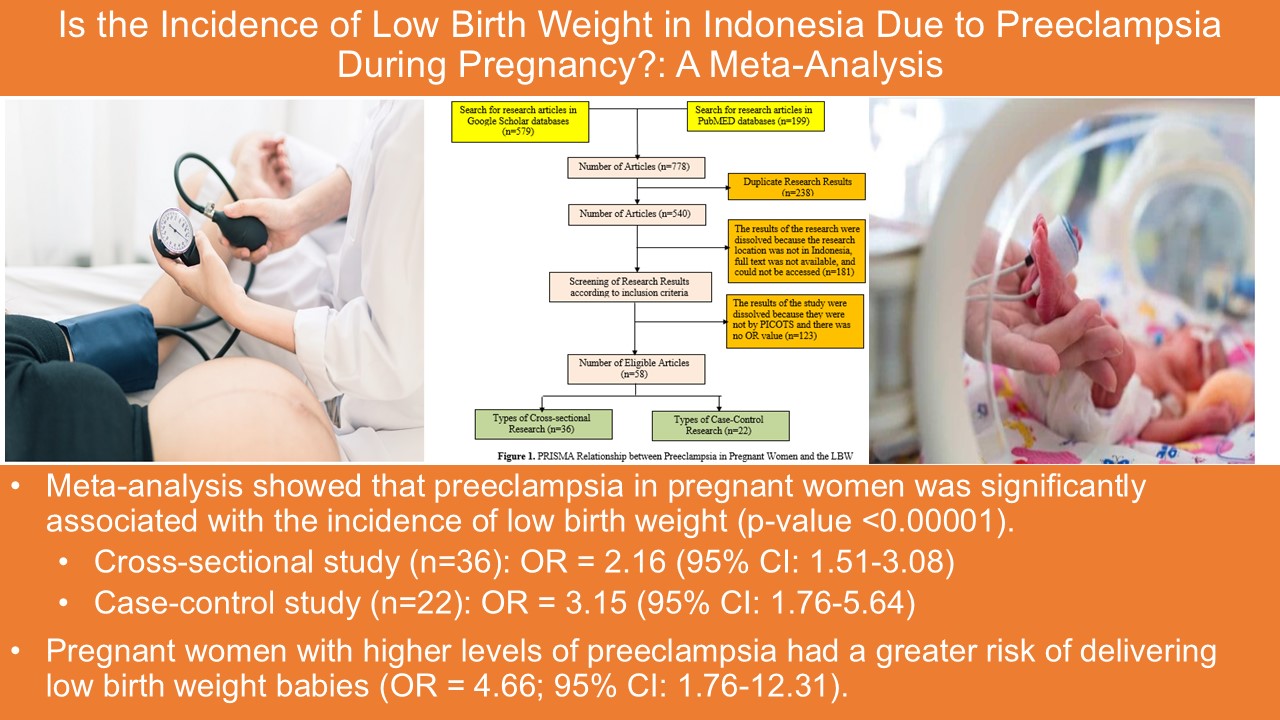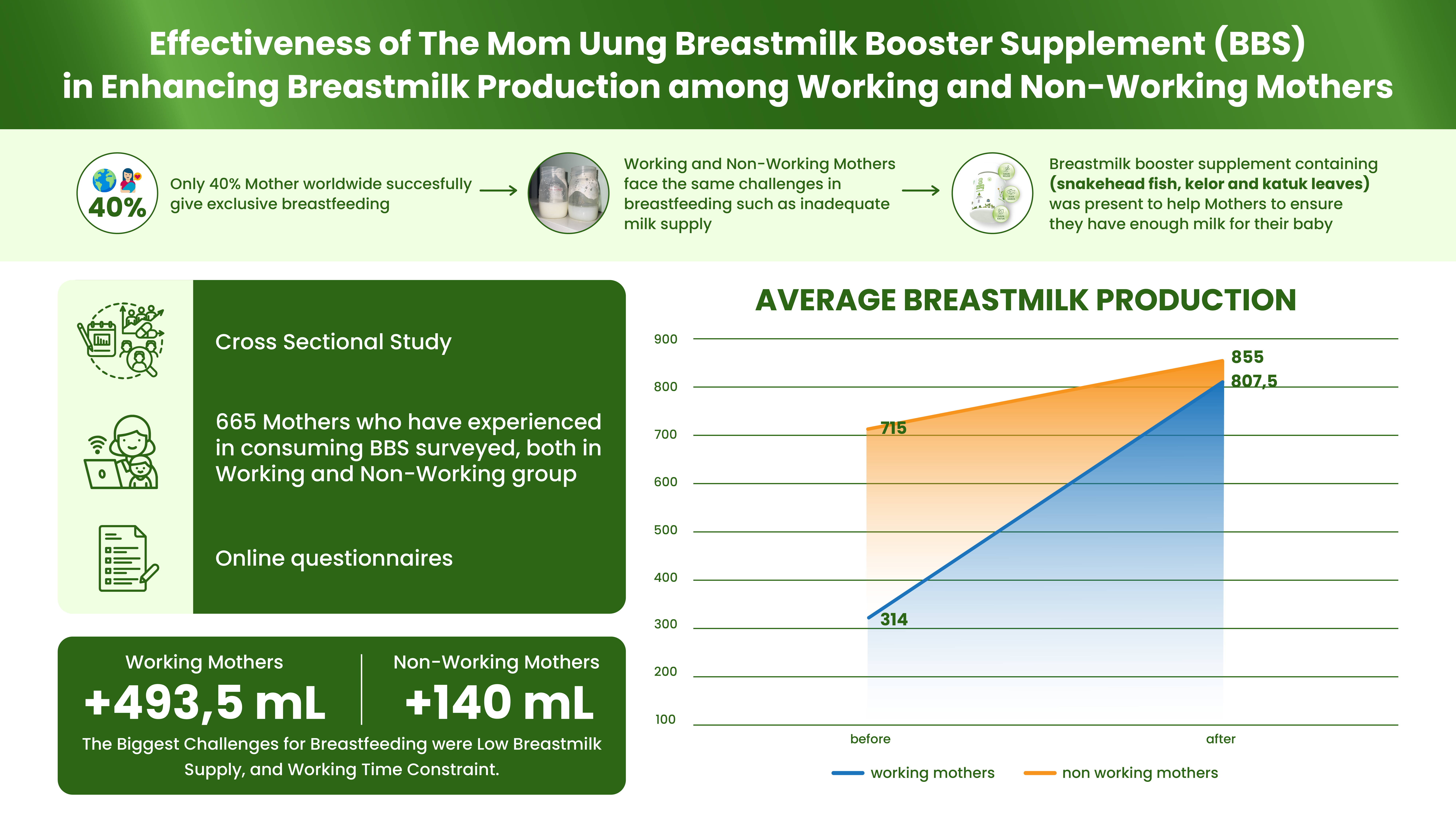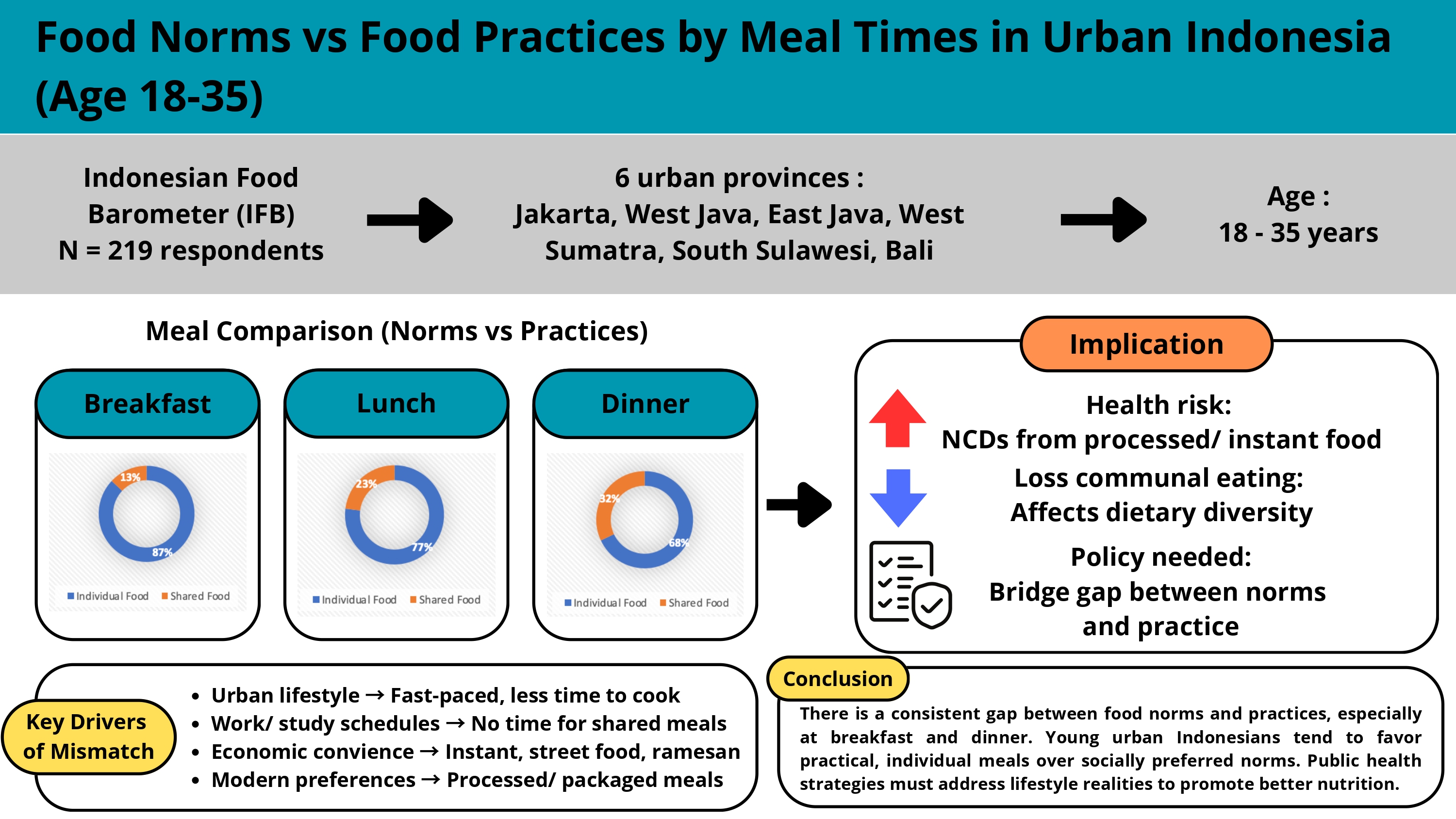ANALYSIS OF MICRONUTRIENT INTAKE, MATERNAL WEIGHT GAIN DURING PREGNANCY, AND PASSIVE SMOKER ON NONSYNDROMIC OROFACIAL CLEFT INCIDENCE AT HARAPAN KITA WOMEN AND CHILDREN HOSPITAL

Downloads
A congenital facial anomaly that manifests as a cleft lip, cleft palate, or both—without the involvement of other organ abnormalities—is known as a non-syndromic orofacial cleft (OFC) (Tobing, 2017). According to the Indonesian Ministry of Health (2019), OFC represents 0.2% of disabilities among Indonesian children aged 24 to 59 months. The causes of OFC are multifactorial. In Indonesia, approximately 7,500 new OFC cases are reported annually, with a rising trend (Purwitasari et al., 2020). This study aimed to investigate the association between micronutrient intake, maternal weight gain during pregnancy, and maternal exposure to secondhand smoke with the incidence of non-syndromic OFC. A case-control study was conducted at Harapan Kita Women and Children Hospital in Jakarta, involving 35 participants in both the case and control groups. Data were collected from both primary and secondary sources. Primary data were obtained through direct interviews with respondents, while secondary data were sourced from maternal and child health (MCH) books. Micronutrient intake was measured using a semi-quantitative food frequency questionnaire (SQ-FFQ). Data analysis was performed using Microsoft Excel 365 and SPSS version 25.0 for Windows, applying logistic regression. The findings indicated that low folic acid and zinc intake, insufficient maternal weight gain during pregnancy, and maternal exposure to secondhand smoke were significantly associated with the development of non-syndromic orofacial cleft (p < 0.05).
Abdulla, R., Tellis, R., Athikari, R., & Kudkuli, J. (2016). Evaluation of homocysteine levels in individuals having nonsyndromic cleft lip with or without palate. Journal of Oral and Maxillofacial Pathology, 20(3), 390–394. https://doi.org/10.4103/0973-029X.190910
Angulo-Castro, E., Acosta-Alfaro, L. F., Guadron-Llanos, A. M., Canizalez-Román, A., Gonzalez-Ibarra, F., Osuna-Ramírez, I., & Murillo-Llanes, J. (2017). Maternal Risk Factors Associated with the Development of Cleft Lip and Cleft Palate in Mexico: A Case-Control Study. Iranian Journal of Otorhinolaryngology, 29(93), 189–195.
Bailey, L. B., Stover, P. J., McNulty, H., Fenech, M. F., Gregory, J. F., Mills, J. L., Pfeiffer, C. M., Fazili, Z., Zhang, M., Ueland, P. M., Molloy, A. M., Caudill, M. A., Shane, B., Berry, R. J., Bailey, R. L., Hausman, D. B., Raghavan, R., & Raiten, D. J. (2015). Biomarkers of nutrition for development-Folate review. Journal of Nutrition, 145(7), 1636S-1680S. https://doi.org/10.3945/jn.114.206599
Bendahan, Z. C., Escobar, L. M., Castellanos, J. E., & González-Carrera, M. C. (2020). Effect of folic acid on animal models, cell cultures, and human oral clefts: a literature review. Egyptian Journal of Medical Human Genetics, 21(1). https://doi.org/10.1186/s43042-020-00108-x
Choi, H., Lim, J. Y., Lim, N. K., Ryu, H. M., Kwak, D. W., Chung, J. H., Park, H. J., & Park, H. Y. (2022). Impact of pre-pregnancy body mass index and gestational weight gain on the risk of maternal and infant pregnancy complications in Korean women. International Journal of Obesity, 46(1), 59–67. https://doi.org/10.1038/s41366-021-00946-8
de Andrade, R. S., Oliveira, F. E. S. de, Martelli, D. R. B., de Barros, L. M., & Martelli Júnior, H. (2023). Maternal consumption of caffeine and second-hand tobacco smoke as risk factors for the development of oral clefts. Clinics, 78. https://doi.org/10.1016/j.clinsp.2023.100266
Dien, V. H. A., McKinney, C. M., Pisek, A., & Pitiphat, W. (2018). Maternal exposures and risk of oral clefts in South Vietnam. Birth Defects Research, 110(6), 527–537. https://doi.org/10.1002/bdr2.1192
Gamayani, U., Idjradinata, P., MH, M., & Achmad TH. (2015). Peran Polimorfisme Gen MTHFR (Methyentetrahydrofolate reductase) Pada Cerebral Palsy. Neurona, 35(2).
Garland, M. A., Reynolds, K., & Zhou, C. J. (2020). Environmental mechanisms of orofacial clefts. Birth Defects Research, 112(19), 1660–1698. https://doi.org/10.1002/bdr2.1830
Gibson, R. S. (2005). Principles of Nutrition assessment Gibson 2nd Ed. Oxford University Press.
Green, R., Allen, L. H., Bjørke-Monsen, A. L., Brito, A., Guéant, J. L., Miller, J. W., Molloy, A. M., Nexo, E., Stabler, S., Toh, B. H., Ueland, P. M., & Yajnik, C. (2017). Vitamin B12 deficiency. Nature Reviews Disease Primers, 3. https://doi.org/10.1038/nrdp.2017.40
Hamid, A., Bilbeisi, E., Khosa, S. M. A., Taleb, M. H., & Afifi, A. M. El. (2023). Assessment of serum , dietary zinc levels , and other risk factors during the third trimester among pregnant women with and without pregnancy-induced hypertension : a case-control study. Frontiers in Nutrition. June, 1–9. https://doi.org/10.3389/fnut.2023.1155529
Haryadi, A., Weraman, P., Ratu, J., Lada, C., & Roga, A. (2022). The effect of folic acid supplementation during early pregnancy on orofacial cleft among children 6–24 months in Kupang City. Neurologico Spinale Medico Chirurgico, 5(3), 123. https://doi.org/10.4103/nsmc.nsmc_27_22
Inchingolo, A. M., Fatone, M. C., Malcangi, G., Avantario, P., Piras, F., Patano, A., Di Pede, C., Netti, A., Ciocia, A. M., De Ruvo, E., Viapiano, F., Palmieri, G., Campanelli, M., Mancini, A., Settanni, V., Carpentiere, V., Marinelli, G., Latini, G., Rapone, B., Dipalma, G. (2022). Modifiable Risk Factors of Non-Syndromic Orofacial Clefts: A Systematic Review. Children, 9(12), 1–24. https://doi.org/10.3390/children9121846
Institute of Medicine. (2009). Weight gain during pregnancy: reexamining the guidelines. National Academies Press.
Jara-Palacios, M. Á., Cornejo, A. C., Narváez-Caicedo, C., Moreano, G., Vásquez, K. P., Moreno-Izquierdo, C., & Romero-Sandoval, N. (2018). Plasma zinc levels in Ecuadorian mothers of infants with nonsyndromic cleft lip with or without cleft palate: A case series. Birth Defects Research, 110(6), 495–501. https://doi.org/10.1002/bdr2.1188
Jarosz, M., Olbert, M., Wyszogrodzka, G., Młyniec, K., & Librowski, T. (2017). Antioxidant and anti-inflammatory effects of zinc. Zinc-dependent NF-κB signaling. Inflammopharmacology, 25(1), 11–24. https://doi.org/10.1007/s10787-017-0309-4
Lopes, G. dos S., Guimarães, L., Nascimento, E., Freitas, D. Q., Rebello, I., Medrado, A. P., Coletta, R. D., & Reis, S. R. A. (2022). Root Curvature in Non-Syndromic Oral Clefts: A Case-Control Study in a Brazilian Population. The Cleft Palate Craniofacial Journal, 61(5), 740–747. https://doi.org/10.1177/10556656221143299
Manuaba IBG. (2012). Ilmu Kebidanan, Penyakit Kandungan, dan KB untuk Pendidikan Bidan (Edisi 2). EGC.
Mendonca, V. J. (2020). Maternal Folic Acid Intake and Risk of Nonsyndromic Orofacial Clefts: A Hospital-Based Case–Control Study in Bangalore, India. Cleft Palate-Craniofacial Journal, 57(6), 678–686. https://doi.org/10.1177/1055665619893214
Munger, R. G., Kuppuswamy, R., Murthy, J., Balakrishnan, K., Thangavel, G., Sambandam, S., Kurpad, A. V., Molloy, A. M., Ueland, P. M., & Mossey, P. A. (2021). Maternal Vitamin B12 Status and Risk of Cleft Lip and Cleft Palate Birth Defects in Tamil Nadu State, India. Cleft Palate-Craniofacial Journal, 58(5), 567–576. https://doi.org/10.1177/1055665621998394
Nasreddine, G., El Hajj, J., & Ghassibe-Sabbagh, M. (2021). Orofacial clefts embryology, classification, epidemiology, and genetics. Mutation Research - Reviews in Mutation Research, 787, 108373. https://doi.org/10.1016/j.mrrev.2021.108373
Nasroen, S.L., Tammama, T., & AN Putri, G. (2022). MTHFR C677T rs1801133 Gene Polymorphism as a Risk Factor for Nonsyndromic Cleft Palate Only among Deutero Malay Sub Race in Indonesia. Journal of Health and Dental Sciences, June, 195–208. https://doi.org/10.54052/jhds.sd22.p195-208
Ni, W., Yang, W., Yu, J., Li, Z., Jin, L., Liu, J., Zhang, Y., Wang, L., & Ren, A. (2019). Association between selected essential trace element concentrations in umbilical cord and risk for cleft lip with or without cleft palate: A case-control study. Science of the Total Environment, 661, 196–202. https://doi.org/10.1016/j.scitotenv.2019.01.171
Pi, X., Li, Z., Jin, L., Liu, J., Zhang, Y., Zhang, L., Wang, L., & Ren, A. (2018). Secondhand smoke during the periconceptional period increases the risk for orofacial clefts in offspring. Paediatric and Perinatal Epidemiology, 32(5),423–427. https://doi.org/10.1111/ppe.12497
Purwitasari, K. T. I., Sanjaya, I. G. P. H., & Hamid, A. R. R. H. (2020). Gambaran faktor risiko penyebab terjadinya celah bibir dan celah langitan di Denpasar tahun 2019. Intisari Sains Medis, 11(2), 697–701. https://doi.org/10.15562/ism.v11i2.656
Sakran, K. A., Abotaleb, B. M., Al-Rokhami, R. K., Hsieh, T. Y., Al-Wesabi, M. A., Mohammed, A. A., Al-Sharani, H. M., Shi, P., & He, D. (2022). Analysis of Environmental Exposures for Nonsyndromic Cleft Lip and/or Palate: A Case-Control Study. Iranian Journal of Public Health, 51(3), 578–586. https://doi.org/10.18502/ijph.v51i3.8934
Sato, Y., Yoshioka, E., Saijo, Y., Miyamoto, T., Sengoku, K., Azuma, H., Tanahashi, Y., Ito, Y., Kobayashi, S., Minatoya, M., Bamai, Y. A., Yamazaki, K., Itoh, S., Miyashita, C., Araki, A., & Kishi, R. (2021). Population attributable fractions of modifiable risk factors for nonsyndromic orofacial clefts: A prospective cohort study from the Japan environment and children’s study. Journal of Epidemiology, 31(4), 272–279. https://doi.org/10.2188/jea.JE20190347
Simko, M., Totka, A., Vondrova, D., Samohyl, M., Jurkovicova, J., Trnka, M., Cibulkova, A., Stofko, J., & Argalasova, L. (2019). Maternal body mass index and gestational weight gain and their association with pregnancy complications and perinatal conditions. International Journal of Environmental Research and Public Health, 16(10), 1–11. https://doi.org/10.3390/ijerph16101751
Spinder, N., Bergman, J. E. H., Boezen, H. M., Vermeulen, R. C. H., Kromhout, H., & De Walle, H. E. K. (2017). Maternal occupational exposure and oral clefts in offspring. Environmental Health: A Global Access Science Source, 16(1), 1–11. https://doi.org/10.1186/s12940-017-0294-5
Tajrin, A., Ruslin, M., Rasul, M. I., Nurwahida, Hadira, Mubarak, H., Oginawati, K., Fahimah, N., Tanziha, I., Damayanti, A. D., Mukhaiyar, U., Arumsari, A., Astuti, I. A., Putri, F. A., & Silvia, S. (2024). Distribution of maternal risk factors for orofacial cleft in infants in Indonesia: a multicenter prospective study. Archives of Craniofacial Surgery, 25(1), 11–16. https://doi.org/10.7181/acfs.2023.00521
Tobing, J. N. (2017). Identifikasi faktor risiko eksogen maternal orofacial cleft non-sindromik. Cdk-257, 44(10), 690–694.
Uwitonze, A. M., Ojeh, N., Murererehe, J., Atfi, A., & Razzaque, M. S. (2020). Zinc adequacy is essential for the maintenance of optimal oral health. Nutrients, 12(4), 1–14. https://doi.org/10.3390/nu12040949
World Health Organization. (2000). Obesity: Preventing and Managing the Global Epidemic. World Health Organization.
World Health Organization. (2013). Tobacco Use and Second-Hand Smoke Exposure in Pregnancy. World Health Organization.

This work is licensed under a Creative Commons Attribution-NonCommercial-ShareAlike 4.0 International License.
- MEDIA GIZI INDONESIA Journal is the copyright owner of all materials published on this website.
- The formal legal provisions for access to digital articles of this electronic journal are subject to the terms of the Creative Commons Attribution-NonCommercial-ShareAlike license (CC BY-NC-SA 4.0), which means that MEDIA GIZI INDONESIA Journal and readers reserve the right to save, transmit media / format, manage in database, maintain, and publish articles as long as it continues to include the name of the Author.
- Printed and published print and electronic manuscripts are open access for educational, research and library purposes. In addition to these objectives, the editorial board shall not be liable for violations of copyright law.


2.png)





















